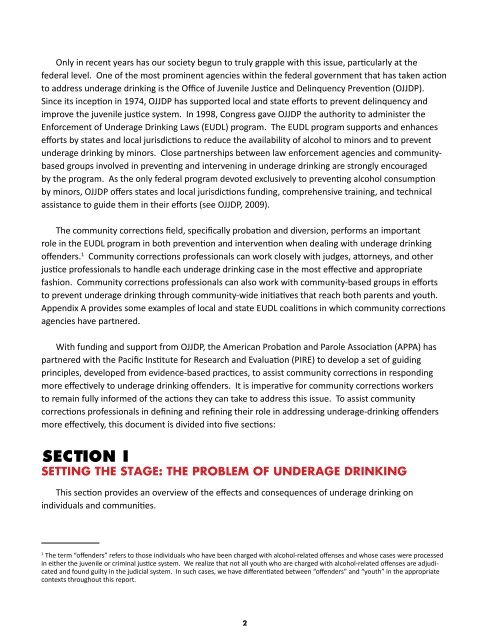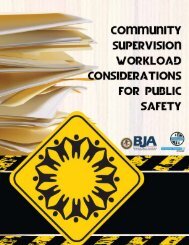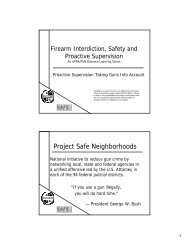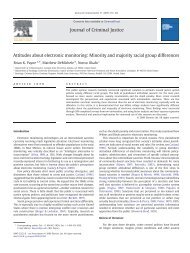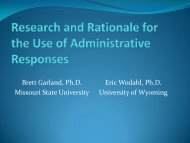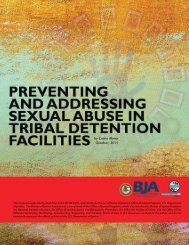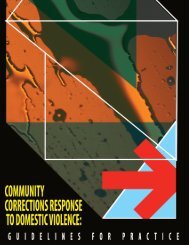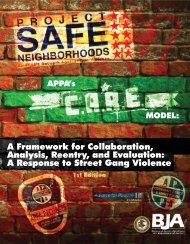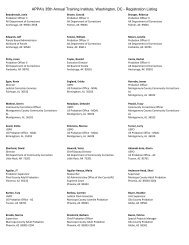Intervention Principles and Practice Guidelines for - Underage ...
Intervention Principles and Practice Guidelines for - Underage ...
Intervention Principles and Practice Guidelines for - Underage ...
You also want an ePaper? Increase the reach of your titles
YUMPU automatically turns print PDFs into web optimized ePapers that Google loves.
Only in recent years has our society begun to truly grapple with this issue, particularly at the<br />
federal level. One of the most prominent agencies within the federal government that has taken action<br />
to address underage drinking is the Office of Juvenile Justice <strong>and</strong> Delinquency Prevention (OJJDP).<br />
Since its inception in 1974, OJJDP has supported local <strong>and</strong> state ef<strong>for</strong>ts to prevent delinquency <strong>and</strong><br />
improve the juvenile justice system. In 1998, Congress gave OJJDP the authority to administer the<br />
En<strong>for</strong>cement of <strong>Underage</strong> Drinking Laws (EUDL) program. The EUDL program supports <strong>and</strong> enhances<br />
ef<strong>for</strong>ts by states <strong>and</strong> local jurisdictions to reduce the availability of alcohol to minors <strong>and</strong> to prevent<br />
underage drinking by minors. Close partnerships between law en<strong>for</strong>cement agencies <strong>and</strong> communitybased<br />
groups involved in preventing <strong>and</strong> intervening in underage drinking are strongly encouraged<br />
by the program. As the only federal program devoted exclusively to preventing alcohol consumption<br />
by minors, OJJDP offers states <strong>and</strong> local jurisdictions funding, comprehensive training, <strong>and</strong> technical<br />
assistance to guide them in their ef<strong>for</strong>ts (see OJJDP, 2009).<br />
The community corrections field, specifically probation <strong>and</strong> diversion, per<strong>for</strong>ms an important<br />
role in the EUDL program in both prevention <strong>and</strong> intervention when dealing with underage drinking<br />
offenders. 1 Community corrections professionals can work closely with judges, attorneys, <strong>and</strong> other<br />
justice professionals to h<strong>and</strong>le each underage drinking case in the most effective <strong>and</strong> appropriate<br />
fashion. Community corrections professionals can also work with community-based groups in ef<strong>for</strong>ts<br />
to prevent underage drinking through community-wide initiatives that reach both parents <strong>and</strong> youth.<br />
Appendix A provides some examples of local <strong>and</strong> state EUDL coalitions in which community corrections<br />
agencies have partnered.<br />
With funding <strong>and</strong> support from OJJDP, the American Probation <strong>and</strong> Parole Association (APPA) has<br />
partnered with the Pacific Institute <strong>for</strong> Research <strong>and</strong> Evaluation (PIRE) to develop a set of guiding<br />
principles, developed from evidence-based practices, to assist community corrections in responding<br />
more effectively to underage drinking offenders. It is imperative <strong>for</strong> community corrections workers<br />
to remain fully in<strong>for</strong>med of the actions they can take to address this issue. To assist community<br />
corrections professionals in defining <strong>and</strong> refining their role in addressing underage-drinking offenders<br />
more effectively, this document is divided into five sections:<br />
Section I<br />
Setting the Stage: The Problem of <strong>Underage</strong> Drinking<br />
This section provides an overview of the effects <strong>and</strong> consequences of underage drinking on<br />
individuals <strong>and</strong> communities.<br />
1<br />
The term “offenders” refers to those individuals who have been charged with alcohol-related offenses <strong>and</strong> whose cases were processed<br />
in either the juvenile or criminal justice system. We realize that not all youth who are charged with alcohol-related offenses are adjudicated<br />
<strong>and</strong> found guilty in the judicial system. In such cases, we have differentiated between “offenders” <strong>and</strong> “youth” in the appropriate<br />
contexts throughout this report.<br />
2


